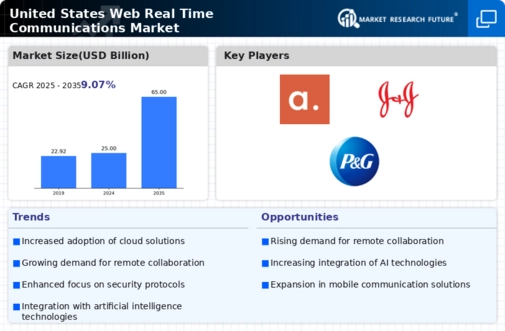Emergence of Innovative Use Cases
The web real-time-communications market is witnessing the emergence of innovative use cases that extend beyond traditional applications. Industries such as gaming, entertainment, and virtual events are increasingly leveraging real-time communication technologies to enhance user engagement. For instance, the rise of virtual reality (VR) and augmented reality (AR) applications is creating new opportunities for immersive experiences that rely on real-time interactions. By 2025, it is projected that the market for virtual events will grow substantially, with many organizations adopting web real-time-communications solutions to facilitate interactive experiences. This diversification of use cases is likely to attract a broader range of customers, from startups to established enterprises, thereby fueling growth within the industry. As businesses explore creative ways to utilize real-time communication, the market is expected to evolve rapidly, reflecting changing consumer preferences and technological advancements.
Increased Focus on Customer Experience
In the web real-time-communications market, there is a notable shift towards enhancing customer experience. Businesses are increasingly recognizing the importance of real-time interactions in building customer relationships and driving satisfaction. As a result, many organizations are integrating web real-time-communications solutions into their customer service strategies. By 2025, it is anticipated that over 60% of customer interactions will occur through digital channels, necessitating the use of effective communication tools. This trend is particularly relevant in sectors such as retail and finance, where timely responses can significantly impact customer loyalty. Companies are investing in technologies that enable live chat, video support, and instant messaging to provide immediate assistance, thereby improving overall customer engagement. This focus on customer experience is likely to be a key driver of growth within the web real-time-communications market.
Advancements in Internet Infrastructure
The web real-time-communications market is benefiting from advancements in internet infrastructure across the United States. The rollout of 5G technology is expected to enhance connectivity and reduce latency, which are critical for real-time communication applications. With 5G networks, users can experience faster data transmission speeds, enabling high-quality video and audio communication. This technological evolution is likely to attract more businesses to adopt web real-time-communications solutions, as improved network capabilities can support a larger number of simultaneous users without compromising performance. As of 2025, it is estimated that 5G will cover over 70% of the US population, further propelling the market's growth. Enhanced internet infrastructure not only supports existing applications but also paves the way for innovative solutions, thereby expanding the potential use cases within the industry.
Growing Demand for Remote Collaboration Tools
The web real-time-communications market is experiencing a surge in demand for remote collaboration tools. As organizations increasingly adopt flexible work arrangements, the need for effective communication solutions has become paramount. In 2025, the market is projected to reach approximately $10 billion, driven by the necessity for seamless interaction among distributed teams. This trend is particularly evident in sectors such as education and healthcare, where real-time communication facilitates remote learning and telemedicine. The rise of remote work has led to a significant increase in the adoption of platforms that support video conferencing, instant messaging, and file sharing, thereby enhancing productivity and collaboration. Consequently, businesses are investing in web real-time-communications technologies to maintain operational efficiency and foster teamwork, indicating a robust growth trajectory for the industry.
Regulatory Compliance and Data Privacy Concerns
The web real-time-communications market is increasingly influenced by regulatory compliance and data privacy concerns. As organizations handle sensitive information, they must adhere to various regulations, such as the General Data Protection Regulation (GDPR) and the California Consumer Privacy Act (CCPA). These regulations necessitate the implementation of secure communication solutions that protect user data. In 2025, it is expected that compliance-related investments in communication technologies will rise significantly, as businesses seek to mitigate risks associated with data breaches. This focus on security and compliance is driving the demand for web real-time-communications solutions that offer robust encryption and data protection features. Consequently, companies are prioritizing vendors that can demonstrate compliance with relevant regulations, thereby shaping the competitive landscape of the industry.














Leave a Comment